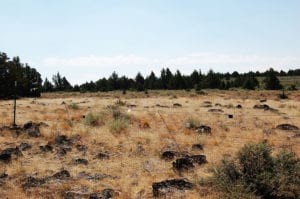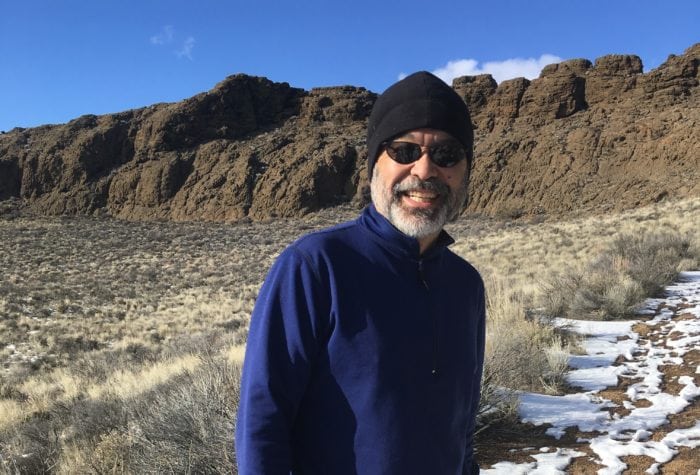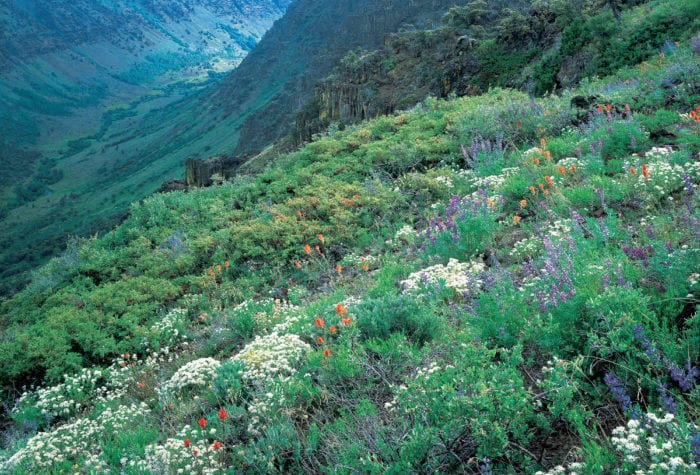Steens Mountain Fence Flagging with BHA
Renee Patrick
| Organizer: Lisa Foster
Start Date: 7/18/2019 End Date: 7/21/2019 Region: Steens Mountain Difficulty Rating: 3 out of 5 Maximum Group Size: 20 participants |
*This trip is offered in collaboration with the Backcountry Hunters and Anglers.
About the place
Steens Mountain has long been known for some of the best backcountry mule deer hunting in the state and is also home to the Donner and Blitzen River, a great trout fishing stream in southeastern Oregon. The mountain lies along the horizon of southeastern Oregon like a sleeping giant among a bed of sagebrush, perennial grasses and wildflowers. Although often mistaken for a chain of mountains, Steens is actually one contiguous monolith — the largest fault block mountain in North America, stretching some 50 miles and reaching a mile vertically, with summits that overlook the Alvord Desert, wide canyons and the Donner und Blitzen River. Steens Mountain is without a doubt one of the best places for a backcountry hunt in Oregon’s high desert.
About the stewardship work
 Greater Sage-Grouse are a key indicator species throughout the Intermountain West. As many as 16 million of these birds once ranged across more than 300 million acres. Habitat loss and other factors have contributed to a steep decline in the population of sage-grouse throughout the west which led to the bird’s consideration for listing under the Endangered Species Act. In 2015, the U.S. Fish and Wildlife Service determined that the listing was “not warranted” due to the conservation plans that were crafted for the recovery of sage-grouse by collaborative groups including the BLM, conservation groups and private entities.
Greater Sage-Grouse are a key indicator species throughout the Intermountain West. As many as 16 million of these birds once ranged across more than 300 million acres. Habitat loss and other factors have contributed to a steep decline in the population of sage-grouse throughout the west which led to the bird’s consideration for listing under the Endangered Species Act. In 2015, the U.S. Fish and Wildlife Service determined that the listing was “not warranted” due to the conservation plans that were crafted for the recovery of sage-grouse by collaborative groups including the BLM, conservation groups and private entities.
Flying into barbed wire fences near lek sites is a significant source of mortality for sage-grouse. The Burns BLM is working to flag fence lines near leks with a reflective tag to increase the visibility of the wire and reduce collisions. These flagging markers have been shown to reduce collisions by up to 83%.
Backcountry Hunters and Anglers will be joining ONDA on this trip. Volunteers will work with ONDA and staff from the Burns BLM to flag up to ten miles of fencing. The work involves hiking cross-country and attaching high visibility markers to the wire so that birds can see the fences in difficult light and weather conditions and avoid collision.
Trip timeline
- Thursday, July 18 (5-8 p.m.): Volunteers should plan to arrive in the evening with enough time to set up, meet others at camp, and spend some time talking about the weekend ahead.
- Friday, July 19 (8 a.m.- 4 p.m.): Plan to leave camp at 8 a.m. with a drive and then a few mile hike to the work site where we will flag up to 10 miles of fencing for the day.
- Saturday, July 20 (8 a.m.- 4 p.m.): The second day of fence flagging. We will work from 8 a.m. to 4 p.m. After the work day, we’ll drive up to the summit of Steens to watch the sunset from almost 10,000 feet.
- Sunday, July 21: Our relaxation day. After breakfast and coffee, volunteers can pack up and head home or try your hand at fishing the lake.
Camp
We will be car camping at a primitive campsite near our project area. There will be plenty of space to spread out and lots of trees for shade. ONDA will bring extra group camping supplies such as tables, chairs, a porta-potty, and wash bins for dishes. We will also have extra potable water, but recommend each participant brings some as well. Since camp is at the vehicles you will be able to have all the amenities you can fit in your car. Further details describing camp and driving directions will be provided to participants in the information e-mail three weeks before the trip.
Difficulty
Challenges include hiking several miles following fence lines cross country (up to eight miles round-trip. The hiking takes place at elevations between 5,000 – 7,000’, and hot daytime temperatures are always a possibility this time of year.
Participant responsibilities
Participants are responsible for their own food, camping gear, potable water, as well as transportation to and from the trip. In the event of sunny and hot weather, please bring up to four liters of water capacity for the day, and consider an electrolyte replacement drink or mix to help you stay hydrated. Sturdy off-trail ankle-high boots, long pants, and a long sleeve shirt (a light weight sun shirt is a great option) are recommended for this trip. Participants should be prepared to be away from camp all day for the work and bring a daypack for lunch, snacks and water.
Gear provided
ONDA and the BLM will provide tools for the work, work gloves, sunscreen and excellent guidance in the field. ONDA will also provide a few group camping items to make things more comfortable (chairs, tables, dish-washing bins, campfire materials, water, shade/rain tarp, etc.) We also provide hot water at morning and evening mealtimes to help expedite meal prep and cowboy coffee in the morning.
Registration
An ONDA registration application and medical form are required for this trip. Check the box next to each trip you would like to attend. You only need to fill this form out once per year.
Apply Now
What happens next?
You will receive a confirmation email within 10 working days of submitting your form. The confirmation email will provide information regarding which trips you are on the “participant list” for, and which trips are full, and therefore you have been placed on the “waitlist.”
Six weeks before the start of the trip, the trip leader will send out an RSVP to make sure everyone is still able to participate. Based on RSVPs, open spaces will be backfilled with people from the waitlist.
Three weeks before the trip start date, registered and confirmed participants will receive driving instructions, maps, car-pooling options, and additional information in an email sent by the trip leader
If you have any questions in the meantime, please don’t hesitate to contact the trip leader.
This trip will be led by Lisa Foster. If you have questions, you can contact her at (541) 330-2638 or email lisa@onda.org.
Meet LisaONDA's Restoration and Stewardship Work
Over the last two decades, ONDA has engaged volunteers in projects to plant thousands of trees, restore dozens of miles of streams, decommission old roads, and remove enough barbed wire […]
Read More
